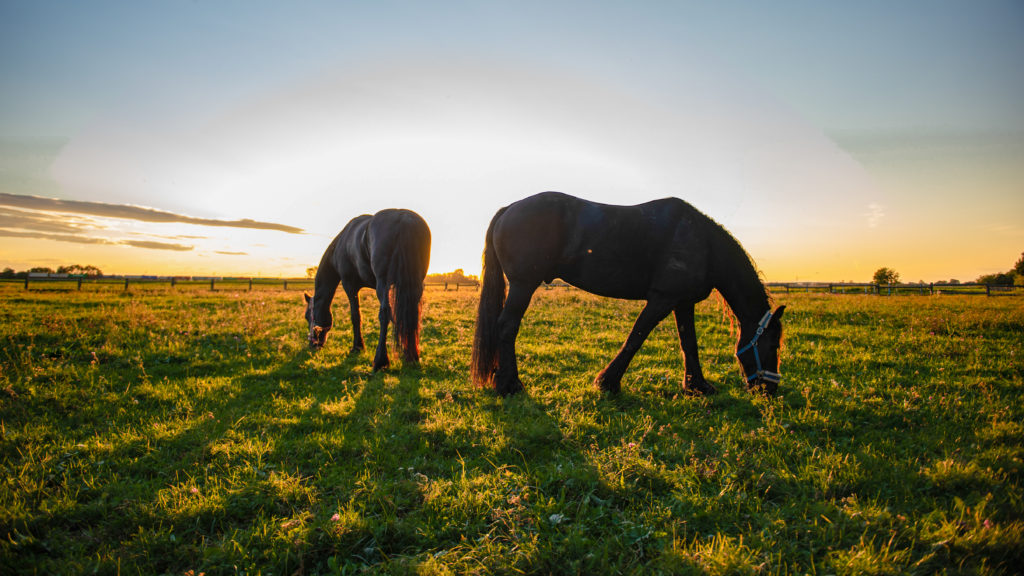I see a lot of horses, and I see a lot of owners who want to make sure their horses are being fed well. However, I also see a lot of confusion as to what my horse SHOULD be eating, and a lot of incorrect assumptions. For this reason, I will be presenting a series of blogs on equine feeding. If you have questions please email me at drcallahan@vmceaston.com.
How do I pick the right feed company?
Selecting the right feeds for your horses can be a time consuming and often confusing task. There are multiple options – low starch, high performance, mare and foal, ration balancer, high fat… It makes your head spin! And the manufacturers, the list seems endless…
To help to narrow down your choices, here is a checklist you can use to help find companies that make high quality, safe, and consistent horse feeds.
Horse dedicated manufacturer
Only a handful of feed manufacturers run a horse dedicated mill. Being horse dedicated means that the risk of anything that could be harmful or even deadly to horses like ionophores (monensin), or antibiotics is eliminated. IF a feed isn’t coming out of a horse dedicated manufacturing facility it is immediately put onto my ‘no’ list. There have been catastrophic mix ups in mixed species mills that have resulted in the deaths of many horses over the years so it just isn’t worth the risk. Choose ones that have dedicated mills.
Set recipes for feeds
There are two main ways a feed can be formulated and made. These are:
- Least cost mixing, where the energy, protein, vitamin and mineral levels of the feed are set but the manufacturer can choose from any number of ingredients at hand to make up the feed at least cost to them; or
- The use of set recipes where the energy, protein, vitamin and mineral levels AND the exact ingredients used are never changed.
To work out which method your feeds are currently being made by look at the ingredients list. Feeds made by least cost will have a statement something like ‘Ingredients selected from’ or ‘contains grains including…’ or they will list obscure ingredients like ‘vegetable protein meals’ which can be anything. Because of the way they are made, least cost feeds can have widely varying protein quality and starch contents from batch to batch which is not ideal for horses.
Choosing products from companies that make feeds using set recipes guarantees you a more consistent, higher quality product.
Protein quality and quantity
The quality of protein used in a feed is a major determinant of how well a horse does on that feed. Look for feeds that list high quality protein sources in the ingredients with soybean meal and full fat soybean being the most desirable followed by cottonseed meal, linseed meal (not linseed oil), brewers grains, distillers grains, alfalfa, and corn gluten. When choosing feeds, ask your manufacturer if they run any sort of testing for protein and what their protocol is for ingredients and feeds that don’t make the grade.
Independent laboratory testing
A company can write anything they like on their feed label with regards to the analysis of the feed. While most companies do a good job of this, some don’t, so it is a good idea to ask if the company regularly has its feeds tested by an independent laboratory to verify the contents of its horse feed. These results should also be made readily available to you on request if you wish to see them.
Further, horse feeds contain a high percentage of mineral ingredients including limestone, calcium phosphates and trace mineral premixes. These raw materials can be contaminated with heavy metals like lead, cadmium and mercury so it is also worth asking whether your feed manufacturer tests raw materials and their finished feeds for heavy metals. Their answer should be yes and they should have strict guidelines controlling their maximum allowed heavy metal levels.
While there are many other considerations when selecting horse feeds including cost, level of customer service and how well a feed fits your purpose, using the four criteria discussed above will help to narrow down your choices from 60+ companies to just a handful. Once you have your shortlist you can then move on to the finer points for the final selection of feeds for your horses.
Let’s start with basics.
The Feed Tag
Why read the feed tag?
Well, it’s pretty important. Have you read the tag on your horse’s feed and do you really know what it says?
First what IS the feed tag?
It’s that little bit of paper attached to the bag.
It tells you:
- Product name and weight
- Purpose statement identifying the type of horse intended to be fed. Checking that your feed has been specifically formulated for your class of horse is critical. For example, you would not want to feed a product designed for a “mature horse at maintenance” to a “young growing horse.”
- Guaranteed analysis of certain nutrients (required by law) – Crude Protein, Crude Fat, Crude Fiber, Acid Detergent Fiber (ADF), Neutral Detergent Fiber (NDF), Calcium, Phosphorus, Copper, Selenium, Zinc, and Vitamin A, and for feeds that include carbohydrate claims (i.e. low starch, etc.), the sugar and starch levels (when added together, the NSC or non-structural carbohydrates)
- Ingredient list – this listing may include individual ingredients such as oats or corn, or terms like “grain products”. There is NO information regarding quality of ingredients in a feed. Ingredients are required to be listed in descending order of amount present.
- Feeding directions – Horse feed manufacturers formulate feeds to be fed at a specific range of feeding rates; when a product is not fed according to the directions, the nutritional benefits of that feed won’t be met (as in the example above, if you are feeding 1 lb of a feed designed to be fed at 5 lb daily, you will not be meeting the nutritional values on the bag)
What a horse feed tag does not tell you:
- Additional nutrients needed by the horse but that aren’t required to be guaranteed
- Nutrient and ingredient quality. The percentage of protein on the bag (i.e.12%) tells you nothing about the quality of that protein. There are countless ways to blend various ingredients to make a feed with 12 % crude protein. A feed containing 12% crude protein made with high quality ingredients will supply more total protein, and more essential amino acids, to the horse than a feed made with lower quality ingredients. The same principle holds true for fat, fiber, vitamin and mineral sources. Not all ingredients are the same quality, stability or availability for the horse.
- Just because something is included, doesn’t mean the level is high enough to be meaningful or useful. Even though an ingredient is listed, it could be that just a trace amount was included (yeast cultures for example).
- Whether or not the guaranteed levels of nutrients are appropriate – when reading horse feed tag guarantees, many horse owners look for the tag with the “most” of everything listed. Sometimes more is not better. Sometimes more is just more and sometimes more is worse, possibly even toxic, as in Vitamin A.
- Quality control – Feed manufacturers have widely differing quality control standards. It’s up to the horse owner to investigate each individual manufacturer’s approach to quality control
Let’s start with the most important thing, which is: What type of forage is your horse eating?
Forage is the most important part of the horse’s diet and your concentrate should complement the type of forage that you are feeding. For instance, you might have great pasture in the summer, but in the winter you are feeding so/so hay. You might need to change what concentrate you feed between the winter and summer from a higher calorie, more fortified feed to a ration balancer. A change from an alfalfa mix hay to a low-quality hay might mean a change in concentrate as well.
Does this feed meet my horse’s age and use requirements?
The feed requirements for a 10 year old pasture puff and a growing 6 month old weanling are completely different. Geriatric horses are another special population. There is no one feed that will meet the needs of all age and use, despite what you see in the ads!
Does this feed meet my horse’s metabolic needs?
Just like people, horses can vary in their individual needs for calories. We all know people who can eat all day and never gain weight and the opposite. Horses are no different. Every horse is an individual and you may need to increase the calorie content of the diet for some, and reduce it for others. Higher fat feeds supply more calories without supplying more starch and sugar, which is healthier for the horse in general.
Is the feed lower in starch and sugar?
The higher the starch and sugar (NSC), the more the risk associated with metabolic problems, such as laminitis. The NSC is especially important in feeding horses with equine metabolic syndrome, laminitis, Cushings, or history of colic. Unfortunately, some manufacturers are very reluctant to share this vital piece of information. Also, just like with human foods, the definition of “low” varies from one company to another. Low doesn’t always mean low. Another thing to consider is the volume of feed that you are feeding. If the label directions are for 6# of a 12% NSC, it might actually be higher in total starch and sugar than 1.5# of a 16%NSC. Another reason to read the label and the feeding directions!
Can I feed it according to the label?
As we discussed in blog 1 and 2, if you are not feeding in the amounts on the feeding direction label, you are not supplying the horse with the minimum requirements of nutrients needed in the diet. So, feeding 1# of feed, when the minimum is 5, or feeding 20# when the maximum is 10, is not optimal for your horse. I see this all the time when people are feeding a pound of low starch feed to their 1000# horse, because he is already too fat. If you can’t feed according to the label amounts, you need to change feeds!
The take home message is that you need to take your horse’s needs into consideration when choosing a feed and you can change feeds as those needs change. It’s ok to change feeds seasonally or if the horse’s energy or growth requirements change. Just do so gradually over a period of 1-2 weeks. If you are not sure, ask your vet or contact a nutritionist. Most feed companies have nutritionists available to answer questions at no charge.
How about “Natural” feeds – is this a better option for my horse?
How about non-GMO feeds?
Surely, they are better – after all, they are more natural!
Well, maybe not…
The horse’s natural diet is composed of forage and forage alone, but since we ask our modern horses to perform a variety of unnatural things, we have to provide the additional calories they need. Our grasses and pastures are on depleted soil, so the hay, grass, or pasture is not balanced in itself.
Some people seem to think feeding unprocessed grains, and non-GMO grains is better for the horse. But, generally, the advantages of feeding straight grains (without additional fortification) are few and the “non-GMO” label has to be taken with a grain of salt.
First, let’s discuss the unprocessed grain diet, i.e. “Natural”
What are cereal grains?
- Oats – Oats are palatable and easy to chew, less susceptible to mold and are considered a safe grain since starch from oats is easily digested in the small intestine. However, they don’t offer all the nutrients needed, cannot be considered a complete feed, and processed oats have a short shelf life.
- Corn – Most horses like the taste of corn. But it’s high in starch (70%), low in protein, may not be completely digestible in the small intestine in large amounts, and undigested starch can trigger colic or laminitis. Also, it molds easily if not stored properly and moldy corn can cause death in horses.
- Barley – Barley contains high energy, moderate protein and low fiber. Crude protein from barley is easier to digest than corn, and the energy is higher than oats, but barley starch has low digestibility in small intestine, and it molds easily if not stored properly.
The problem with just feeding cereal grains is that they vary widely in their nutrient profile. Some have adequate protein for a mature horse when paired with grass hay, but others do not. Cereal grains do not contain a balanced nutrient profile, and they must be paired with some type of additional fortification. A straight cereal grain diet is unsuitable for young, growing, or geriatric horses, due to the lack of the essential amino acids especially lysine and methionine.
In order to make grains digestible for the horse, they must be processed in some way such as crimping, rolling, steaming or cooking. Cereal grains also are a high starch meal. The horse’s digestive system is easily upset with high starch meals, and big swings in insulin can result, leading to insulin resistance, equine metabolic syndrome and in young horses, possible links to OCD development.
Hard keepers may not be able to take in enough calories from a cereal grain ration; the use of fats and fibers in commercial feeds allow them to condense the number of calories per pound.
Why a Concentrate?
Concentrates, or commercial feeds are formulated specifically for the needs of a horse and a certain class, type or usage. If chosen and used properly, commercial feeds represent the total nutrition package. Benefits of commercial feeds include:
- They’re uniform and consistent.
- They’re generally easy to digest.
- They have an extended shelf life.
- They guarantee a consistent intake of nutrients.
- They simplify ration balancing.
- They give the owner options for horses with problems such as poor teeth or respiratory tract disorders or poor forage availability.
How about non-GMO feeds – are they better?
Non-GMO means that the ingredients do not contain genetically modified organisms. A GMO is a plant, animal, microorganism, or other organism whose genetic makeup has been modified using recombinant DNA methods (also called gene splicing), gene modification, or transgenic technology. Virtually all the soybean crop, as well as corn, alfalfa, sugar beets, and cotton in the US is now GMO.
Certain crops grown in the U.S. are not genetically engineered, and these include oats, barley, wheat, rice, sorghum, and millet.
Unfortunately, the term “Non- GMO“ product is not federally regulated; therefore, companies are on the honor system.
The problems?
- Sourcing non-GMO product is difficult and these crops are more expensive, which raises the price of the feed substantially.
- The feed is produced in mills that also use GMO products, so the feed will have residues (or more) GMO products in them.
- Some products, such as soybeans, have no non-GMO alternative. That means that soybeans are not included in non-GMO feed. Soybeans are rich in lysine, an essential amino acid. For that reason, the non-GMO feeds are not suitable for young, growing horses or broodmares, as the lysine content is too low, and the protein is made up of lesser quality amino acids.
- These feeds tend to be higher in starch and sugar, and usually are not suitable for horses with Cushings, equine metabolic syndrome, or those who are starch sensitive.
So, if you are willing to pay at least $2-$3 more per bag, and you are feeding a mature animal with no health or weight issues, the non-GMO feeds may be suitable to feed. If you don’t want to feed them, be reassured that long term studies in multiple species have shown no difference between those fed GMO and those fed non-GMO feeds…
In many cases, they are the perfect feed to feed our easy keepers or laminitic horses, as well as our horses on poor quality hay.
Why do I like them so much and what are they?
If the forage supplies adequate energy, horses will either maintain their weight or gain weight, and this may seem as though all of the other nutrient requirements are being met.
Unfortunately, with today’s forages this may be a false assumption. Many times, there are inadequate amounts of protein, vitamins, and minerals in the forage required for the work asked of the horse, whether it is performance, growth, or reproduction.
Easy keepers are sometimes fed lower nutritional quality hays at lower amounts to reduce calorie intake. They may need additional protein just to meet requirements.
But beyond just meeting requirements there is the issue of protein quality. Even a grass hay that provides adequate crude protein might lack adequate levels of some essential amino acids.
Ration balancers not only provide crude protein, they tend to provide guaranteed levels of the most limiting essential amino acids, such as lysine and methionine, that are vital.
The advantage of using a balancer pellet is that the horse owner can meet the horse’s requirement for protein, vitamins, and minerals.
A balancer pellet can be used three ways:
1) alone as a low-calorie source of protein, vitamins, and minerals;
2) combined with straight grains, such as oats or corn or
3) as a top-dress for a concentrate fed at less than the recommended feeding rate.
There are two different kinds of balancers: one to feed with grass diets and one to feed with alfalfa diets. This is because the nutrients are formulated to complement your horse’s diet.
If your horse consumes more than 50% of his forage in grass, pasture or grass hay, he should have the grass formula. If he consumes more than 50% of his forage in alfalfa, then he should have the alfalfa formula.
Why are they good?
- They are low calorie and low starch
- They are meant to be fed in small amounts (1-2# day).
- They have little grain content
- They have added high quality proteins such as lysine and methionine, which aren’t present in lower quality hay and pasture
Common misconceptions
- They cost more and are too expensive
- They have too much protein (Egads – 30%!!!)- my horse will get high or it will stress his kidneys
So, first the expense
A bag of balancer is going to cost around $30, while a high end sweet feed costs somewhere around $16. How can the balancer be cheaper?!?
It comes down to amounts that must be fed. Feed 2 # of balancer per day (what the label says for your horse – remember that label!), vs the 7# of feed the sweet feed bag label says. The bag of balancer will last you 25 days, the sweet feed 7 days. So, you will spend 3 times as much on the sweet feed, and be feeding your horse way more grain – not an ideal situation.
If you reduce the amount of sweet feed, yes, it will make your bag last longer, but remember that label? That feed is meant to be fed in the minimum amount on the bag. If you aren’t, you aren’t feeding a balanced diet.
Ok, how about all that protein!?!
Use a comparison in protein levels between ration balancers and performance feeds. Most performance feeds have crude protein levels around 12% and a daily recommended intake upwards of 5 pounds per day. At 5 pounds per day this would provide 0.6 pound of protein or the same as two pounds of the 30% ration balancer. In fact, performance feeds given at the upper ends of the recommended feeding levels provide far more protein a day than the ration balancer.
When should you not use a ration balancer?
- If you are feeding adequate amounts (i.e. label amounts) of a high-quality feed and forage.
- If you need more energy in the diet (to increase weight, to add more energy), you will need to add a source of calories such as fats or grains. Increasing the ration balancer does not add more calories and here is a case where more does not equal better.
When should you use one?
- Poor quality forage or hay
- Poor muscling, poor toplines
- Dieting horses (laminitic, Cushings)
- Easy keepers
- Whenever you are not feeding the given feeds according to label directions





